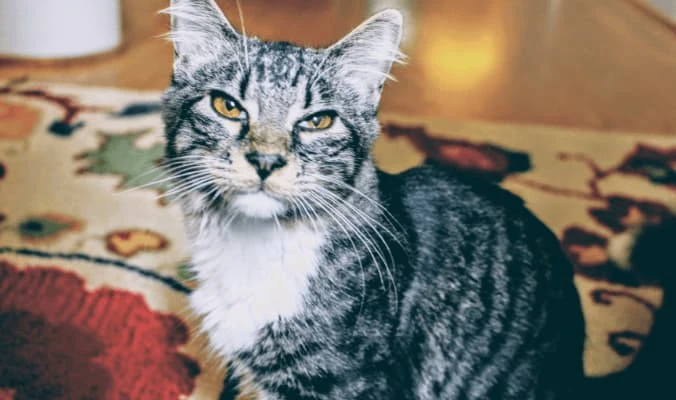Carpet Care for Pet Owners
Published on Mar 16, 2021

We love our pets but unfortunately, they can be mess makers for your carpet.
Whether it is dirt from their paws, shedding fur or leaving urine in their wake, your carpet may be a little worse for wear thanks to your furry friend.
We’ve gathered some of the biggest problems your pet creates for your carpet and how you can best protect your floors.
How to Choose The Best Carpet for Your Pet
If you’re in the market for new carpet and have pets at home, there are a few things you need to consider.
1. The best carpet pile

Carpet pile is the length and thickness of the carpet fibre used to weave the carpet. There are two kinds of carpet pile: loop pile and cut pile. Cut pile is best for pets, as loop pile can get caught on your pet’s claws. Once this happens, they tend to want to rip it up and pull it out just for fun.
2. The best carpet fibre

In general terms, carpet fibres are either natural like wool or synthetic like nylon and polyester.
The best choice for pet owners is a solution dyed synthetic carpet. With a solution dyed fibre, the dye is added during the mix of the solution which means that the dye/colour is all the way through the fibre (do you remember the Colgate ads with Mrs Marsh and the chalk?).
Traditional nylon carpets are treated with acid dyes after the fibre is manufactured, meaning the dye bonds to the outside of the fibre but does not penetrate all the way through the fibre. Higher end nylon carpet and triexta carpets are solution dyed and will be more resistant to staining and colour loss.
3. The best colour and pattern

Pet dander is comprised of shed hair, dead skin and urine proteins. It’s important to clean this out of your carpet but for the sake of aesthetics, choose a carpet with a pattern and one that is a similar colour to your pet’s fur.
How to Keep Your Carpet Fresh

1. Vacuum, vacuum and vacuum again
The key to maintaining a carpet with pets is to vacuum regularly. Use a high quality upright with a beater bar and a HEPA filter, not just a stick vacuum (this will only do half the job). Regular vacuuming will pick up the pet fur and dander, maintaining the appearance of your carpet and dramatically improving indoor air quality.
2. Annual carpet clean
If you have pets that spend a lot of time indoors, you should have carpets professionally cleaned at least once a year to ensure adequate removal of pet dander and dust mites.
How do you remove pet odour and stains from carpet?

Here is what happens when your pet leaves urine in your carpet.
The liquid enters the carpet, soaks down and spreads. The size of the spot you can see is generally a lot smaller than the size of the affected area in the backing of the carpet, the underlay and the floor.
Urine is a surfactant (breaks down surface tension), so each time the pet returns to that spot, the affected area beneath the carpet fibres gets bigger as the urine penetrates further and further.
So as much as we love our pets, their urine stains can cause a great deal of damage.
How to Treat Urine Stains on Carpet
-
Remove as much of the liquid as possible by placing a thick absorbent towel on the area and applying downwards pressure. Stand on the towel for added effect and enable the towel to wick-up the moisture, pulling it from below the carpet fibres.
Repeat using a fresh piece of towel until there’s no further transfer of moisture to the towel.
-
If the stain has dried, you need to rehydrate the urine using a 2:1 mix of warm water and white vinegar. Pour on the affected area before soaking it up with the above step.
-
Mix a solution of 2 cups of warm water, 1 tablespoon of liquid dishwashing detergent and 1/2 cup of vinegar. Dip a soft cloth in the solution and blot the stain gently until the stain is removed.
-
We recommend using a product to kill any remaining bacteria. Electrodry Sells E-Pet by Restezy to target bacteria and neutralise the odour. It also contains active ingredients to deter the pet from returning to the same place.
How You Can Prevent Carpet Damage

-
When your pet sheds hair, it can leave a trail of destruction that may damage your vacuum cleaner. Wrap some duct tape (or similar) around an old paint roller and roll it across your carpet. It will act like a lint roller and pick up large clumps of hair.
-
You should be vacuuming a couple of times a week if you have an inside pet, preferably using a vacuum with a HEPA-filter.
-
Invest in rugs (nothing too fancy) to catch any dirt coming off paws. The great thing about rugs is they’re quick to vacuum and if major damage occurs, you haven’t ruined your whole carpet.
-
An abrasive mat at the door is a good idea too, to stop both pets and humans dragging muck inside.
-
Try your best to keep your pet’s paws clean and nails clipped. Try to keep on top of grooming as well.




